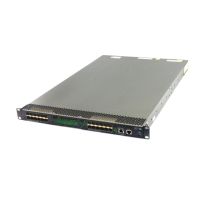43
Configuring a trunk VSAN
FC interfaces, FC aggregate interfaces, and VFC interfaces can be assigned to multiple VSANs as trunk
ports.
If you assign an interface to VSANs as a trunk port multiple times, the new configuration does not
overwrite the old configurations. The final trunk VSAN list is the union of all the VSANs to which you have
assigned the interface.
To assign an interface to the specified VSANs as trunk ports:
Ste
Command
Remarks
1. Enter system view.
system-view N/A
2. Enter FC interface, FC
aggregate interface, or VFC
interface view.
interface { fc | vfc |
san-aggregation }
interface-number
N/A
3. Assign the interface to the
specified VSANs as a trunk
port so that the interface
allows the specified VSANs
to pass through.
port trunk vsan vsan-id-list
By default, an interface does not
belong to any VSANs (including
VSAN 1) as a trunk port.
You can assign an interface to a
nonexistent VSAN as a trunk port.
Displaying and maintaining VSANs
Execute display commands in any view.
Task Command
Display the member ports of VSANs. display vsan [ vsan-id ] port-member
VSAN configuration examples
VSAN configuration example by using FC interfaces
Network requirements
As shown in Figure 22, configure the SAN to meet the following requirements:
• Server A can read and write only the data of Disk A and Disk B.
• Server B can read and write only the data of Disk C.

